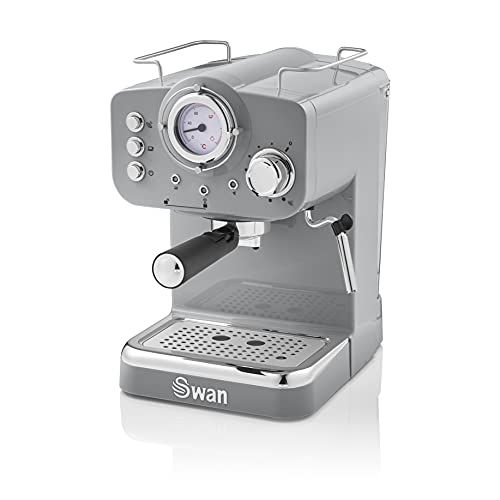How to Build a Professional Espresso Machine
This is a fantastic option for cafes and coffee shops that wish to attract customers who are enthralled by espresso and barista skills. It's the official machine for the World Barista Championships, and it displays.
The barista is able to refill the water reservoir during their shift. The machine comes with a tea hot water tap and cool-touch steam wands.

Water
A commercial espresso machine has to produce a large quantity of espresso-based drinks in an efficient manner. These machines are usually made of stainless steel, which is tough and resistant against cracks and scratches. Espresso machines made of stainless steel make it easier to clean and maintain.
A high-quality machine must include a separate shut-off valve for the water pipe to avoid limescale build-up. This will ensure that any repairs are only limited to the affected parts of the machine and will not interfere with the other operations.
Test your water to ensure it's being treated correctly. For example distillate water can be refining by adding a small amount of minerals back into it. This can reduce its erosion properties and improve the taste, but it can also damage some machines. espresso makers remineralized wate can make the boiler sensor believe that the machine is full and it isn't. This could cause excessive heat and damage to the machine.
Grinder
The grinder is a crucial component of a successful espresso maker. It takes a raw, unground bean and turns it into finely ground coffee that can be properly tamped into the filter basket, resulting in an excellent extraction.
Professional commercial machines come with grinders that are programmed for various sizes of drinks. This ensures constant results every time. Super-automatic machines go one step further and automatize the entire process from brewing to grinding and dispensing. These kinds of machines tend to earn high marks in Lab tests due to their hands-off simplicity of use.
Manual or semi-automatic machines require more effort from the barista but often the results are worth the effort. This model won an 2022 Good Housekeeping Coffee Award for its smart dosing feature which weighs and delivers the right amount of ground coffee each time. It also features an low-pressure pre-infusion system for an even extraction, and a milk frother that made dense, thick steamed milk during our tests.
Temperature
When it is time to make espresso temperature, it plays an important impact on the flavor and quality of your espresso. If the water temperature is not at a suitable degree, it can result in the extraction being impeded and may even result in a bitter cup.
Fortunately, espresso machines of high-end quality include tools that allow you to keep your water at the correct temperature. One method for doing this is by utilizing PIDs, which monitors and adjusts the temperature of the water. Double boiler systems are another method to do this. You can use one boiler to heat water and steam for tea, while using the second boiler to heat the water to brewing temperature.
Carles says that these kinds of systems can be beneficial for large-scale businesses and baristas working at home. They make it easier for newbies to get the perfect shot of espresso because they can maintain an accurate temperature and avoid a lot of the factors that can alter the flavor profile. It can also make it easier for experienced baristas to make their shots exactly the way they want them.
Pressure
The pressure that an espresso machine uses is another aspect that influences the quality of the coffee it makes. Many espresso drinkers have noticed that their drinks have a distinct taste different based on the amount of pressure that is used, even though all other elements remain the same.
In general, commercial-grade machines utilize nine bars of pressure to brew espresso. These machines are also more likely to be steam driven than pump-driven. While higher-pressure machines exist they generally require a more sophisticated group head design to handle the higher pressure levels.
While you may see espresso machines advertising 15 or even 18 bars of pressure, nine bars are generally regarded as the gold standard for consistently excellent brews. These machines that are higher pressure tend to be more affordable and designed for home use.
To put 9 bars of pressure into perspective, it's more than four times the amount of pressure that is exerted by the air in your car tire. The more pressure that a professional espresso maker is able to apply, the better it will be at extracting flavor out of the coffee beans you love. It's worthwhile to invest in high-end machines that will give you the most effective results.
Barista Skills
Baristas must be able to accept and process customer orders quickly and efficiently. This is especially important during busy times in the coffee shop. Effective customer service skills are essential for building relationships with customers and boosting sales for the coffee shop. This includes recognizing regular customers, resolving problems efficiently, and remaining positive and amiable in tough situations.
A strong ability to multitask is often required for baristas as they may be required to take orders, operate the cash register, communicate orders to coworkers and answer calls at the same time. This skill allows the customer to enjoy an enjoyable experience at the coffee shop by making sure that orders are delivered promptly.
It is helpful for a barista to have knowledge of the various kinds of drinks that can be prepared with an espresso machine. You can get acquainted with the various kinds of espresso by reading about their characteristics, tasting the drinks in person and by watching online videos. Many baristas consider it beneficial to attend classes on the subject, which are offered by a variety of organizations.
